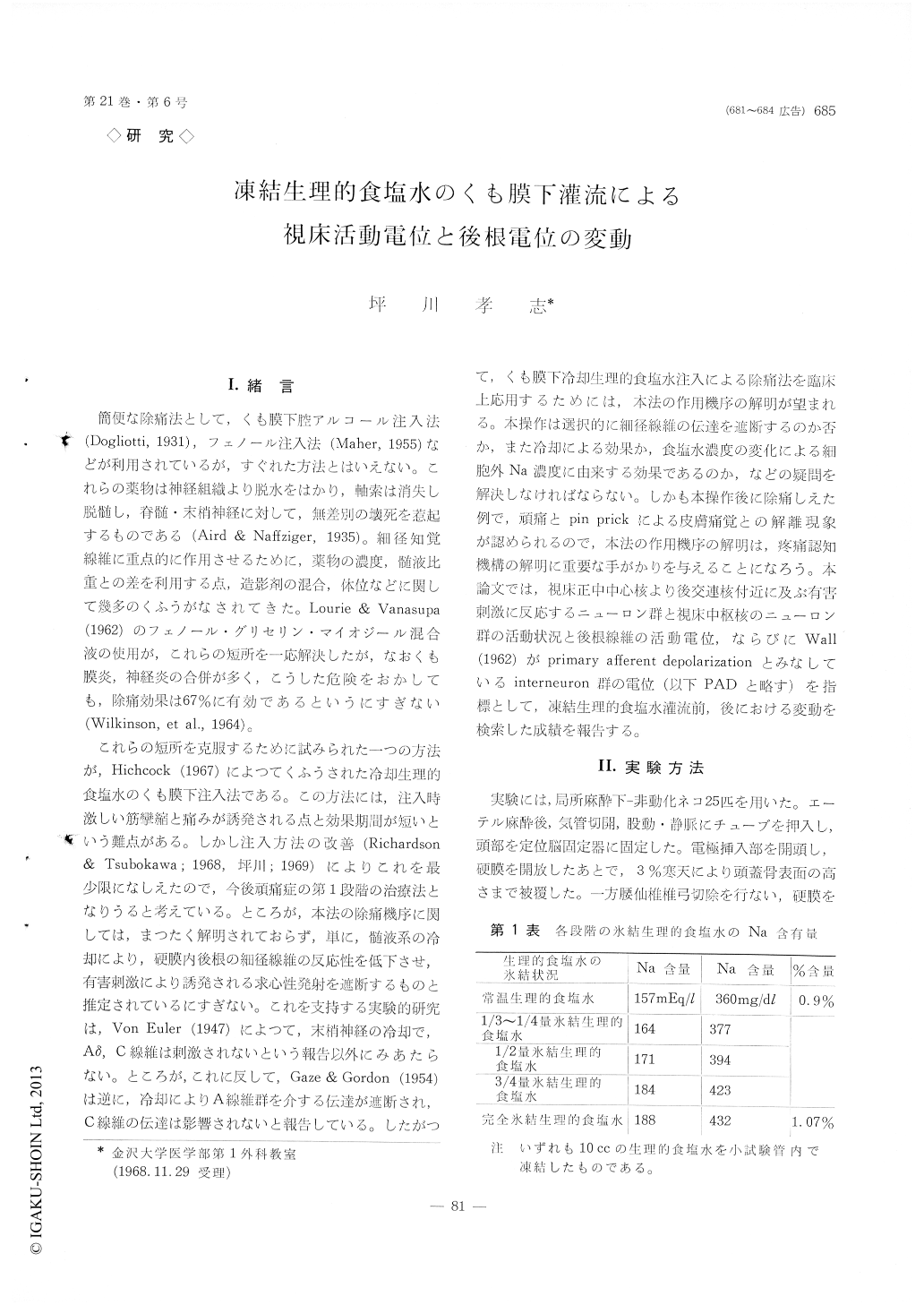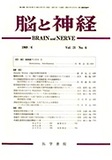Japanese
English
- 有料閲覧
- Abstract 文献概要
- 1ページ目 Look Inside
I.緒言
簡便な除痛法として,くも膜下腔アルコール注入法(Dogliotti,1931),フェノール注入法(Maher,1955)などが利用されているが,すぐれた方法とはいえない。これらの薬物は神経組織より脱水をはかり,軸索は消失し脱髄し,脊髄・末梢神経に対して,無差別の壊死を惹起するものである(Aird & Naffziger, 1935)。細径知覚線維に重点的に作用させるために,薬物の濃度,髄液比重との差を利用する点,造影剤の混合,体位などに関して幾多のくふうがなされてきた。Lourie & Vanasupa(1962)のフェノール・グリセリン・マイオジール混合液の使用が,これらの短所を一応解決したが,なおくも膜炎,神経炎の合併が多く,こうした危険をおかしても,除痛効果は67%に有効であるというにすぎない(Wilkinson, et aL,. 1964)。
これらの短所を克服するために試みられた一つの方法が,Hichcock (1967)によってくふうされた冷却生理的食塩水のくも膜下注入法である。この方法には,注入時激しい筋攣縮と痛みが誘発される点と効果期間が短いという難点がある。しかし注入方法の改善(Richardson & Tsubokawa; 1968,坪川;1969)によりこれを最少限になしえたので,今後頑痛症の第1段階の治療法となりうると考えている。ところが,本法の除痛機序に関しては,まつたく解明されておらず,単に,髄液系の冷却により,硬膜内後根の細径線維の反応性を低下させ,有害刺激により誘発される求心性発射を遮断するものと推定されているにすぎない。これを支持する実験的研究は,Von Euler (1947)によって,末梢神経の冷却で,Aδ,C線維は刺激されないという報告以外にみあたらない。ところが,これに反して,Gaze & Gordon (1954)は逆に,冷却によりA線維群を介する伝達が遮断され,C線維の伝達は影響されないと報告している。したがって,くも膜下冷却生理的食塩水注入による除痛法を臨床上応用するためには,本法の作用機序の解明が望まれる。本操作は選択的に細径線維の伝達を遮断するのか否か,また冷却による効果か,食塩水濃度の変化による細胞外Na濃度に由来する効果であるのか,などの疑問を解決しなければならない。しかも本操作後に除痛しえた例で,頑痛とpin prickによる皮膚痛覚との解離現象が認められるので,本法の作用機序の解明は,疼痛認知機構の解明に重要な手がかりを与えることになろう。本論文では,視床正中中心核より後交連核付近に及ぶ有害刺激に反応するニューロン群と視床中枢核のニューロン群の活動状況と後根線維の活動電位,ならびにWall (1962)がprimary afferent depolarizationとみなしているinterneuron群の電位(以下PADと略す)を指標として,凍結生理的食塩水灌流前,後における変動を検索した成績を報告する。
The purpose of this article is to find out the basic mechanism of the relief of intractable pain following intrathecal perfusion of frozen physiological saline.
(1) The action potential of Aδ and C fiber of intradural dorsal root responding to stimulation of sciatic nerve are disappeared and primary afferent depolarization by sciatic stimulation is also altered following perfusion of the frozen saline (60-80cc) at the lumbo-sacral level.
(2) Following intrathecal perfusion of the frozen saline, VPL evoked potential responded to sciatic nerve is not detected any alteration except shorting of positive phase following inital negative wave. But the responses of centre median and MRF are completly disappear and the effects continue at least one week after perfusion.
(3) The unitary firing of VPI. is just correspond to its evoked potential responding to sciatic stimula-tion. But the interval histogram of thalamic neuron which respond to noxious stimuli changes to more irregular pattern and its distribution curve is close to it of VPL. These neurons do not show any kind response to sciatic stimulation nor noxious stimuli.
(4) On the fifth day after perfusion, 11% of recorded neurons which respond to noxious stimuli before perfusion is still no response to sciatic stimul-ation nor noxious stimuli, 72% of recorded neurons shows same response as it of VPL and 17% of the neurons shows same response as pre-perfusion state.
(5) The percentage of non-response neurons to noxious stimuliis increased following two or three times perfusion in one week. And Effective period also increases to 2 weeks or more.
According these sesults, it is able to block conduc-tion of Aδ and C fiber, and to alter primary af-ferent depolarization at dorsal colum. The thalamic neurons responding to noxious stimuli do not acti-vate by noxious stimuli and sciatic stimulation following two or three times perfusion of frozen saline through the sub-arachnoidal space at the level of lumbo-sacral area. This technique might be use-full treatment for the relief of intractable pain except it locating on the face and high cervical area. And the pain receptive mechanism of thala-mus was discussed by these results.

Copyright © 1969, Igaku-Shoin Ltd. All rights reserved.


